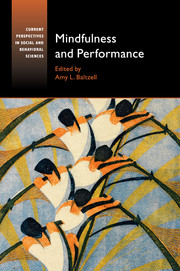Book contents
- Frontmatter
- Dedication
- Epigraph
- Contents
- List of figures
- List of tables
- List of contributors
- Preface
- Acknowledgments
- I INTRODUCTION TO MINDFULNESS: HISTORY AND THEORETICAL UNDERSTANDING
- 1 Mindfulness Scholarship and Interventions: A Review
- 2 Mindfulness, Emotion Regulation, and Performance
- 3 Self-Compassion, Distress Tolerance, and Mindfulness in Performance
- 4 Flow and Mindfulness in Performance
- 5 Peak Performance: Langerian Mindfulness and Flow
- 6 Langerian Mindfulness and Liminal Performing Spaces
- II FORMAL MINDFULNESS INTERVENTIONS IN SPORT
- III MINDFULNESS: THEORY TO PRACTICE IN SPORT AND EXERCISE
- IV MINDFULNESS AND THE PERFORMING ARTS
- V MINDFULNESS FOR COACHES, PRACTITIONERS, AND MENTORS
- VI FUTURE DIRECTIONS
- Index
- References
3 - Self-Compassion, Distress Tolerance, and Mindfulness in Performance
from I - INTRODUCTION TO MINDFULNESS: HISTORY AND THEORETICAL UNDERSTANDING
Published online by Cambridge University Press: 05 January 2016
- Frontmatter
- Dedication
- Epigraph
- Contents
- List of figures
- List of tables
- List of contributors
- Preface
- Acknowledgments
- I INTRODUCTION TO MINDFULNESS: HISTORY AND THEORETICAL UNDERSTANDING
- 1 Mindfulness Scholarship and Interventions: A Review
- 2 Mindfulness, Emotion Regulation, and Performance
- 3 Self-Compassion, Distress Tolerance, and Mindfulness in Performance
- 4 Flow and Mindfulness in Performance
- 5 Peak Performance: Langerian Mindfulness and Flow
- 6 Langerian Mindfulness and Liminal Performing Spaces
- II FORMAL MINDFULNESS INTERVENTIONS IN SPORT
- III MINDFULNESS: THEORY TO PRACTICE IN SPORT AND EXERCISE
- IV MINDFULNESS AND THE PERFORMING ARTS
- V MINDFULNESS FOR COACHES, PRACTITIONERS, AND MENTORS
- VI FUTURE DIRECTIONS
- Index
- References
Summary
The focus of this chapter addresses both theoretical and applied considerations of how to help athletes deescalate from performance triggered emotionally reactivity through self-compassion. Researchers and practitioners bringing mindfulness to the performance realm are offering new pathways to cultivate mind states that support enhanced performance. Yet, for some athletes, being asked to accept aversive thoughts or just focus on novel stimuli is not enough. Some performers who suffer from intense negative emotions as a result of fear or harsh self-criticism, particularly resulting from high-pressure performance expectations, may need more than current mindfulness interventions in sport. Some athletes require more support coping with debilitating thoughts and emotions beyond practitioners guiding athletes to tolerate their feelings (such as terror) and refocus on the task at hand. Zella Moore (in Chapter 2) offers a persuasive theoretical and conceptual argument for the place of emotion regulation in the mindfulness and performance arena. The ultimate goal is to help performers be more empowered to emotionally regulate appropriately in the face of intensive anxiety or fear with the goal of optimal performance.
The quality of the internal experience of the athlete must be given more attention as we consider how to create mindfulness interventions such that athletes are willing to accept and, at worst, tolerate what emerges internally while engaged in the world of competition and high-demand performance. We need to offer athletes more than simply prompting them toward raw acceptance and exploration of what is occurring moment to moment; athletes who are suffering need more guidance than simply to hold an openness and curiosity to moment-to-moment internal and external experience, when such moments are at times extremely difficult to tolerate (e.g., performance anxiety). I contend that helping performers with emotional tolerance via practices of self-compassion is a pathway to support athletes becoming more mindful and fully engaged in moment-to-moment experience and ultimately perform better.
As a practicing sport psychologist, I have witnessed myriad stories of elite athletes and musicians who become unable to function in their performance realm due to overwhelming thoughts and emotions. Many of these said performers had first seen psychologists, psychiatrists, and/or medical doctors for help (for psychological and somatic symptoms, respectively) – and to no avail.
- Type
- Chapter
- Information
- Mindfulness and Performance , pp. 53 - 77Publisher: Cambridge University PressPrint publication year: 2016
References
- 7
- Cited by

